Greeting Card Industry Statistics 2026: Insights and Data
Last Updated: December 15, 2025
Share to social media
The latest greeting card industry statistics reveal a surprising truth: even in the digital age, the tradition of sending heartfelt messages on paper is far from fading.
In fact, over 6.5 billion greeting cards are still purchased each year in the U.S. alone.
From birthdays to “just because” moments, greeting cards remain a cherished way to express care and connection. As technology, sustainability, and personalization reshape consumer habits, the industry is evolving to meet new expectations.
In this report, we explore the current state of the greeting card market, highlight key global trends, and uncover what's driving its resilience in 2025.
Whether you're a business owner, creative professional, or simply someone who loves sending cards, get ready to dive into the numbers and the heart behind this enduring industry.
Table of Content
How popular are greeting cards?

Despite facing a slight projected decline, the industry continues to generate billions globally.
Grand View Research notes that the global market was valued at US$15.2 billion in 2023 and is expected to reach US$12.2 billion by 2030, reflecting a CAGR of -3.2%.
Birthday cards remain the most popular, accounting for more than 50% of all card sales with over 7 billion units sold annually.
Meanwhile, using free ecards are growing in popularity, especially among Gen Z and Millennials, due to their convenience and customizability.
Here's a glimpse into how popular greeting cards are:
Greeting card market size
Globally, the market size is estimated to be around US$15.2 Billion in 2023, according to ResearchAndMarkets.com.
While growth projections hover around a CAGR of -3.2% between 2022 and 2030, the industry is still expected to reach a revised size of US$12.2 Billion by 2030.
Top sellers
Birthday cards are the most greeting cards sold, with over 7 billion sold each year. They account for more than 50% of all types of cards sold.

Greeting card industry statistics by segments: A World of options
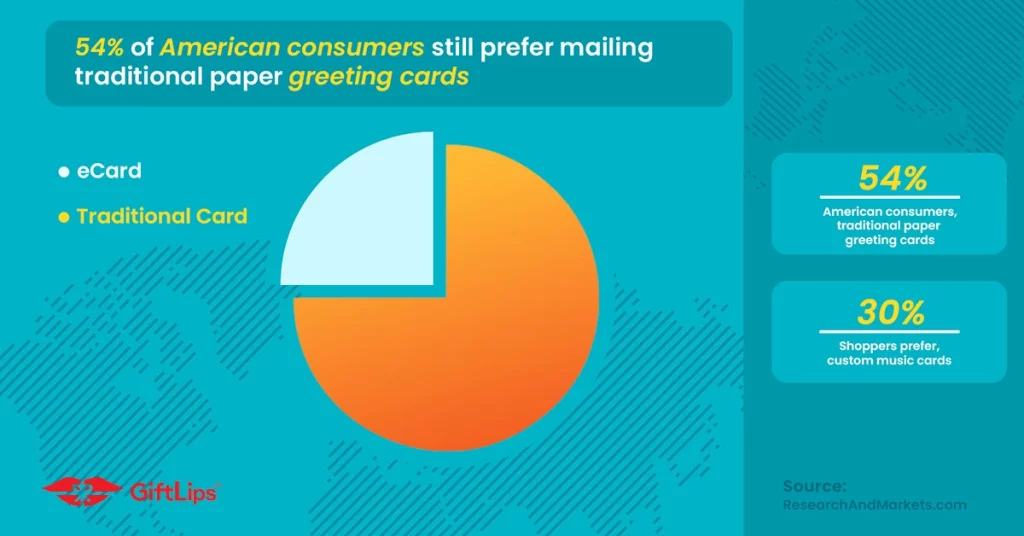
The greeting card industry may seem monolithic, but a closer look reveals a diverse landscape catering to a variety of preferences. Here's a breakdown of some key segments shaping the market, along with important gift card statistics that highlight consumer behavior:
Traditional greeting cards vs. e-cards
A 2023 Shutterfly study revealed that 54% of American consumers still prefer mailing physical cards.
This preference is rooted in emotional value, personalization, and tradition.
However, e-cards are gaining ground, driven by features like animations, sound, and interactivity.
According to Huuray, 30% of shoppers prefer custom music cards or humorous cards.
There might not be a clear winner yet, but the fight is on!
Personalized greeting cards
Consumers are increasingly seeking greeting cards that feel unique and special, which aligns perfectly with the rise of personalized greeting cards.
Platforms now offer advanced tools for customizing messages, fonts, and even uploading photos.
AI-based suggestions are also on the rise, helping users create deeply personal cards.
Handmade greeting cards
There's something undeniably special about a handmade greeting card. The time and effort put into creating a unique piece speaks volumes about the sender's feelings.
E-commerce websites like Etsy have witnessed a surge in the popularity of handmade greeting cards, catering to those who appreciate artisanal craftsmanship and supporting small businesses.
Eco-friendly greeting cards
Sustainability is a growing concern for consumers, and the greeting card industry is taking notice.
There's a rising demand for eco-friendly greeting cards made from recycled paper, sustainable materials like bamboo, and even plantable seeds.
Digital greeting cards
Today's digital greeting cards often incorporate interactive features, animations, and even augmented reality elements.
This evolution makes them more engaging and shareable, particularly for younger audiences.
Online card platforms are also exploring ways to integrate social media and personalization into the digital greeting card experience.
Distribution channels: where greetings get delivered
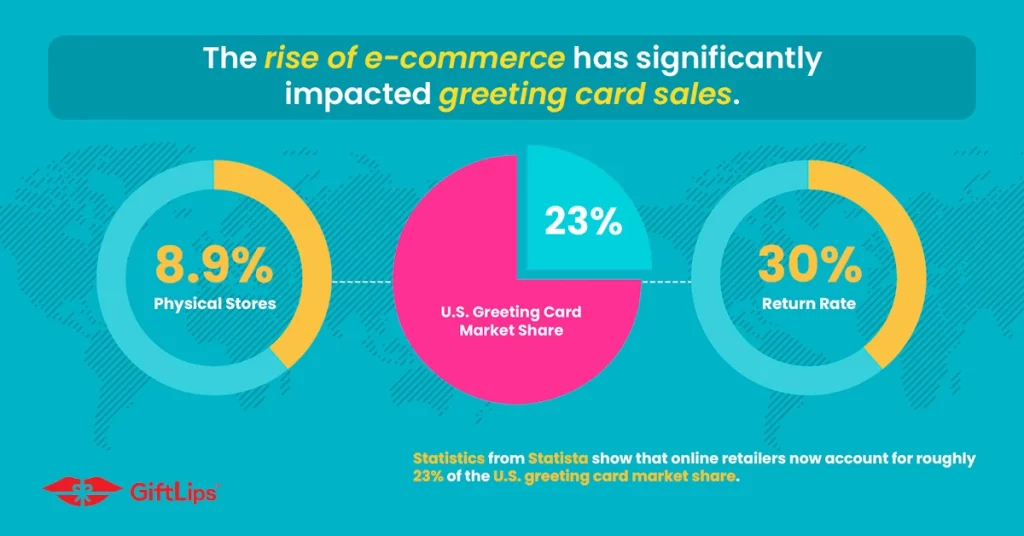
The journey a greeting card takes from the manufacturer to your loved one's hands has become increasingly diverse.
Explore the key distribution channels shaping the industry:
Online retailers
Convenience, broader selection, and fast delivery are driving online sales. Statistics from Statista show that online shopping now accounts for roughly 23% of the U.S. greeting card market share.
This growth can be attributed to the undeniable convenience online shopping offers: browsing from your couch, accessing a wider selection of cards, and often enjoying faster delivery options.
Brick-and-mortar stores
While online sales are booming, physical stores remain a crucial part of the greeting card landscape.
Compared to online shopping, which has physical limitations, browsing cards in a brick-and-mortar store allows for a more thorough inspection.
This can lead to a lower return rate of around 8.9% for physical stores, while online retailers might experience a return rate closer to 30%.
Specialty gift shops
For those seeking unique cards with a touch of personality, specialty gift shops are the way to go.
These stores often carry a curated selection of handmade, locally sourced, or niche greeting cards that cater to specific tastes and interests.
While their market share is smaller compared to online giants or large retail chains, specialty gift shops provide a personalized shopping experience.
They also cater to a loyal customer base who value the human touch and the opportunity to discover hidden gems.
Subscription services
Subscription services delivering greeting cards directly to your doorstep are gaining traction.
This caters to busy individuals who might forget special occasions or simply want the convenience of having a constant supply of cards on hand.
A video greeting card maker like GiftLips offer various subscription models, allowing customers to choose the frequency and style of cards they receive.
While the market share for subscription services is still relatively small, it's a segment to watch as consumer preferences for convenience are constantly evolving.
Regional markets: greetings card industry statistics around the world

North America
The greeting card industry in North America is expected to maintain a steady growth trajectory, with a projected Compound Annual Growth Rate (CAGR) of 1.4% from 2023 to 2030.
This indicates a market that, while not experiencing explosive growth, remains relevant and enduring to consumer spending.
The U.S. holds the leading position within the North American greeting card market, and this dominance is expected to continue.
By 2030, the U.S. greeting card industry statistics are forecast to reach a value of US$6,026 million, solidifying its position as a powerhouse in the industry.
While the U.S. takes the top spot, both Canada and Mexico showcase promising growth.
Canada's greeting card market is expected to see a CAGR of 1.9% from 2023 to 2030, while Mexico's market is anticipated to grow at a CAGR of 2.4% during the same timeframe.
This indicates a thriving industry across North America, with each country offering unique growth opportunities.
The market is segmented by type into traditional cards and e-cards and by distribution channels through offline and online channels.
Geographically, the market is segmented into the United States, Mexico, Canada, and the Rest of North America.
Europe
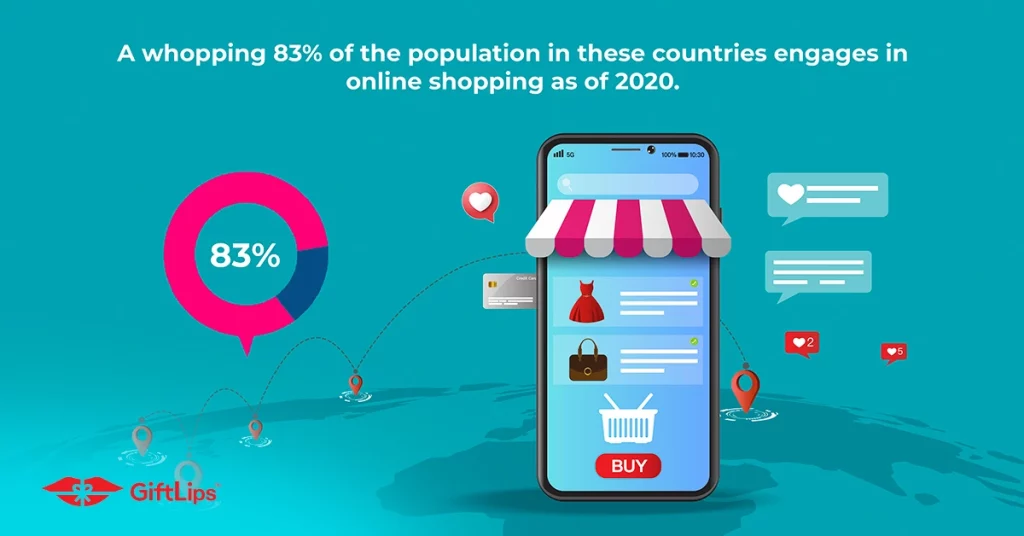
The European greeting card industry statistics is projected to have a compound annual growth rate (CAGR) of 1.5% between 2023 and 2030.
This growth reflects the enduring popularity of greetings in Europe, where tradition and innovation go hand-in-hand.
Western Europe is leading the e-commerce charge within the region.
As of 2020, a whopping 83% of the population in these countries engaged in online shopping.
The United Kingdom, Germany, Spain, and the Nordic countries stand out for their high average consumer spending per capita on greeting cards.
This highlights the cultural significance of greetings in these regions.
Furthermore, rising disposable income and the expansion of e-commerce platforms across Europe are expected to be key drivers of market growth.
Germany is the dominant player in the European greeting card market, and its leadership is expected to continue.
The German market is projected to reach a staggering market value of US $1,572.7 million by 2030.
While Germany reigns supreme, both the UK and France demonstrate promising growth trajectories.
The UK market is anticipated to see a CAGR of 1.1% from 2023 to 2030, while France's market is expected to experience a more robust growth of 2% during the same period.
It indicates a dynamic and diverse European greeting card landscape with exciting opportunities for growth across the continent.
Asia-Pacific
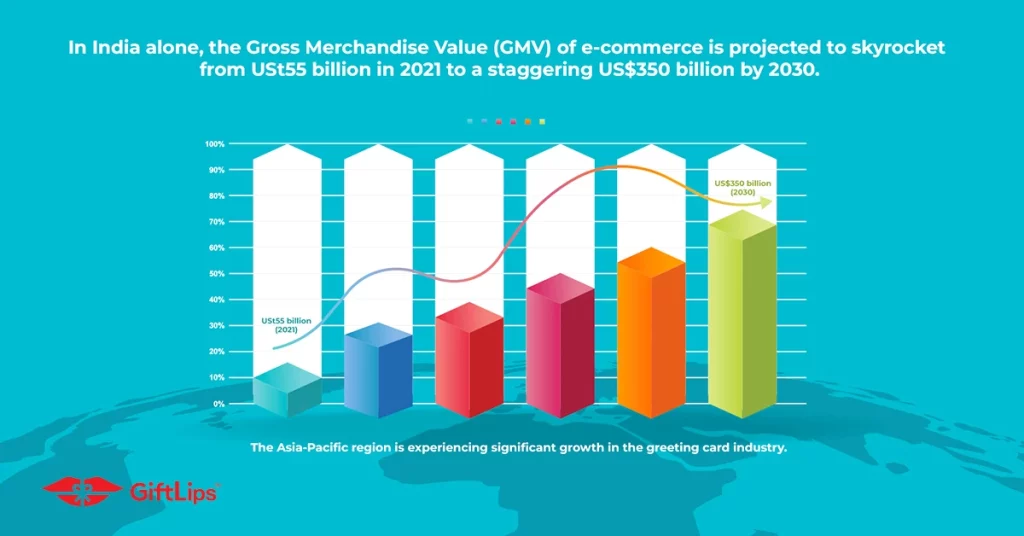
The Asia-Pacific region is experiencing significant growth in the greeting card industry. This can be attributed to a rising middle class and increasing disposable income.
In India alone, the Gross Merchandise Value (GMV) of e-commerce is projected to skyrocket from US$55 billion in 2021 to a staggering US$350 billion by 2030.
China is currently the dominant player in the Asia-Pacific greeting card market, and this trend is expected to continue.
By 2030, the Chinese market is projected to reach a significant market value of US$1,798.5 million, solidifying its position as a leader.
However, other countries are catching up. Japan boasts a steady CAGR of 1.6% from 2023 to 2030, while India is projected to experience an even more robust growth of 2.2% during the same period.
And while traditional occasions like birthdays and Lunar New Year remain important, there's a growing trend towards personalized and digital greetings, particularly among younger generations.

Latin America, Middle East, and Africa
The Latin America, Middle East, and Africa greeting card industry statistics is poised for steady growth, with a projected Compound Annual Growth Rate (CAGR) of 2.3% between 2023 and 2030.
Latin American culture is known for its warmth and vibrancy, which is reflected in the greeting card industry.
Cards often feature bright colors, bold designs, and sentimental messages. Although birthdays and holidays are popular occasions for card-giving.
Some religious holidays like Christmas and Easter also play a significant role in the market.
The Middle East and Africa, on the other hand, represent emerging markets in the greeting card industry.
Featuring cultural nuances and a growing middle class present exciting opportunities.
However, limited distribution channels and a preference for more personalized forms of communication, like phone calls, are some challenges to overcome.
Greeting card customization
The greeting card industry has traditionally relied on pre-designed cards for various occasions.
However, a new trend is emerging: the power of personalization.
Consumers are increasingly seeking cards that feel unique and special, reflecting their individual style and the recipient's personality.
Why personalized designs are on the rise
There are several factors driving this trend:
- Uniqueness and sentimentality: A personalized greeting card goes beyond the generic. It allows you to express your feelings with a special touch, making the recipient feel truly valued and appreciated.
- Standing out from the crowd: With a sea of pre-designed template cards available, personalization allows you to create a card that's truly unique and reflects the recipient's personality or interests.
- The rise of digital tools: Technological advancements have made it easier than ever to personalize greeting cards. Online platforms and even some brick-and-mortar stores offer user-friendly tools to add photos, names, custom messages, and even choose unique fonts and layouts.
Technology enhances customization
Technology plays a crucial role in the rise of personalized greeting cards.
Online platforms allow users to upload photos, edit layouts, and personalize messages with ease.
Some platforms even offer features like augmented reality, making the card even more interactive and engaging.
Others also allow you to incorporate social media elements into your card, like a collage of photos or a shared memory.
Today, artificial intelligence can be used to suggest designs, messages, or even photos based on the recipient's interests and your relationship with them.
Impact on consumer engagement and loyalty
The ability to personalized cards has a significant impact on consumer behavior:
- Increased engagement: The ability to create a unique and personal card fosters a deeper emotional connection with the recipient.
- Enhanced brand loyalty: When a platform offers a seamless and user-friendly experience for personalization, it encourages repeat customers and builds brand loyalty.
- A return to tradition with a modern twist: Card customization breathes new life into the traditional greeting card, making it a relevant and cherished way to express emotions in the digital age.
Consumer demand for greeting cards
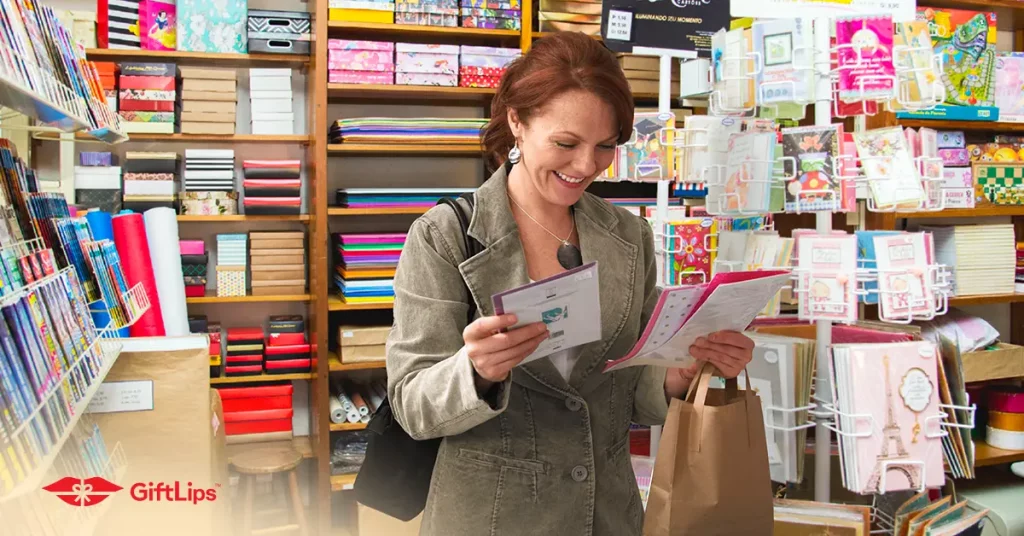
Despite the dominance of digital communication, greeting cards endure as a powerful tool for expressing emotions.
Consumer preferences and buying habits are undergoing a metamorphosis. Let's delve into the key factors shaping demand for greeting cards in this dynamic landscape:
Shifts in consumer preferences
Consumers are increasingly seeking custom greeting cards that feel unique and resonate with the recipient on a personal level.
Generic messages printed on mass-produced cards just don't hold the same weight anymore.
The trend towards personalization allows for the creation of cards that truly reflect the recipient's personality and the sender's emotions.
This can involve adding photos, crafting custom messages that go beyond simple greetings, or choosing unique designs that cater to specific interests.
Occasions driving card purchases
While birthdays remain the undisputed champion of card-giving occasions, other events still hold significance:
- Holidays: Traditional holidays like Christmas, Hanukkah, Kwanzaa, and Diwali continue to be a time for sending cards with warm wishes and seasonal cheer.
These cards often feature festive designs and messages tailored to the specific holiday's traditions.
- Life milestones: Special occasions like graduations, weddings, retirements, or new baby arrivals are often marked with celebratory greeting cards.
Cards like these express congratulations, well wishes, and heartfelt emotions for the recipient's significant life event.
- Just because moments: The growing popularity of thinking of you messages on cards demonstrates a desire to connect and show appreciation outside of traditional holidays and events.
Often featuring lighthearted designs or uplifting messages, these cards can brighten someone's day and strengthen interpersonal bonds.
Influence of social media and digital communication
The rise of social media and digital communication has undoubtedly impacted greeting card usage.
While some might see it as a threat, social media can also play a role in driving card purchases in several ways:
- Digital inspiration: Social media platforms like Pinterest and Instagram can be good sources of unique and personalized card designs.
Scrolling through feeds filled with creative card ideas can inspire consumers to purchase cards for upcoming occasions or discover online platforms that offer personalization options.
- Sharing the sentiment: People might use social media to share photos of themselves with greeting cards they've received, further promoting the act of card-giving.
This act of sharing can normalize card-giving and even spark a trend, encouraging others to send cards to their loved ones.
- Complementary gestures: E-greetings and social media messages can co-exist with traditional cards, creating a multifaceted approach to expressing good wishes.
A digital greeting card message might be sent as a quick update or to coordinate plans.
On the other hand, a physical card with a heartfelt message serves as a more permanent and sentimental keepsake for a special occasion.
Greeting card industry challenges
The greeting card industry, like many others, faces a constantly evolving landscape.
While consumer demand for heartfelt connection remains strong, there are challenges that require adaptation and innovation.
Here, we'll explore some of the key hurdles the greeting card industry must overcome:
The digital age and e-cards
The rise of social media and instant messaging platforms has undoubtedly challenged traditional greeting cards.
E-cards offer undeniable convenience and cater to a preference for immediate communication.
Changing consumer preferences
Consumers today crave unique and personalized experiences.
Generic cards with pre-printed messages struggle to compete with the ability to customize greetings to reflect the recipient's personality and the sender's specific emotions.
Evolving retail landscape
The decline of brick-and-mortar stores, which were once a primary source of greeting card sales, poses a challenge.
Consumers are increasingly shifting towards online shopping, requiring greeting card companies to create a strong online presence and effective distribution channels.
Environmental concerns
Many consumers are becoming increasingly concerned about sustainability.
Traditional greeting cards often involve paper, glitter, and other materials that might raise environmental questions.
The industry needs to adapt by offering eco-friendly alternatives made from recycled materials or exploring biodegradable options.
Rising production costs
Fluctuations in material costs, production processes, and global factors can impact the profitability of greeting card companies.
Finding ways to optimize production and potentially exploring direct-to-consumer models might be necessary to maintain affordability for customers.
Greeting card industry opportunities: a canvas for innovation

While challenges exist, the greeting card industry statistics prove it isn't without silver linings. Here, we delve deeper into exciting opportunities that hold the potential to propel the industry forward:
Personalization
The craving for unique expressions is a goldmine for innovation.
Imagine interactive greeting card platforms that allow users to upload short video messages alongside their greetings.
It can also be an AI-powered tool suggesting personalized jokes based on the recipient's interests.
Niche product lines catering to specific hobbies, professions, or even cultural celebrations can tap into this desire for individuality.
This consistency can create a loyal customer base.
Digital integration
Technology can be a powerful ally, not a foe.
Upgrade to video greeting message embedded with QR codes that, when scanned, unlock a funny video greeting or a personalized message.
Augmented reality features could bring static images to life, creating an interactive and immersive experience for the recipient.
Social media integration could allow for seamless sharing of the card's message or a photo of the recipient holding it.
It creates a heartwarming digital footprint alongside the physical card.
Omnichannel strategy
Consumers today expect a seamless buying experience, regardless of platform.
Companies that can bridge the gap between online and offline channels will be well-positioned for success.
Picture user-friendly online stores with intuitive customization options.
Then, collaborate with retailers who curate unique card selections tailored to their local customer base.
This creates a multi-pronged approach that caters to diverse shopping preferences and maximizes reach.
Sustainable solutions
Environmental consciousness is no longer a niche concern. According to greeting card industry statistics, the market can embrace this by utilizing recycled paper, biodegradable materials, and eco-friendly inks.
Partnerships with sustainable forestry initiatives and offering plantable greeting cards.
You can embed these cards with seeds are just some ways to showcase environmental commitment.
This not only reduces the industry's environmental footprint.
It also resonates with a growing segment of environmentally conscious consumers who are eager to support responsible businesses.
Greeting cards: more than just paper in a digital age
The world's gone digital, but greeting cards are holding their own! Sure, there's competition from texts and emails, but according to the rising greeting cards industry statistics, they are adapting.
Sure, there are challenges.
Digital greetings are convenient, and generic cards with cheesy messages just don't cut it anymore.
But here's the good news: greeting cards are fighting back!
The bottom line is greeting cards aren't going extinct. They're just getting cooler.
By offering personalization, techy features, and eco-friendly options, the industry is making sure greeting cards stay relevant.
So next time you want to show someone you care, don't underestimate the power of a well-chosen (and maybe even interactive or video greeting) card.
Frequently asked questions
How much does the greeting card industry make a year?
The global greeting card industry statistics were estimated to be worth US$15.9 billion in 2022. In the US, the greeting cards and other publishing industry's market size was US$6.8 billion in 2023, a 0.9% decline from the previous year.
What type of cards sell the most?
Birthday cards reign supreme! Recent studies show that consumers purchase more than 7 billion birthday cards every year.
